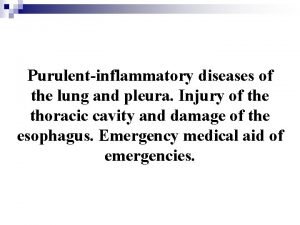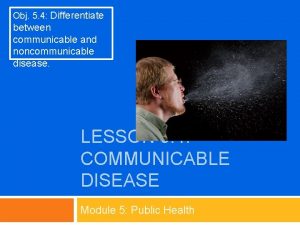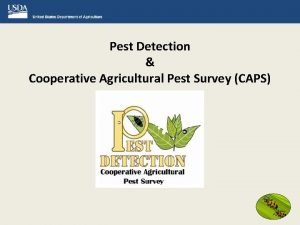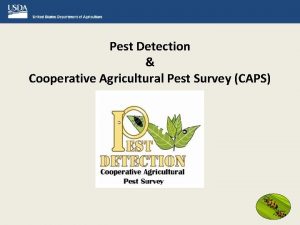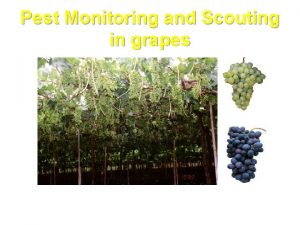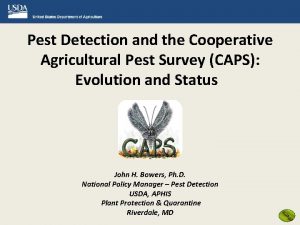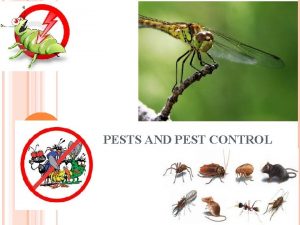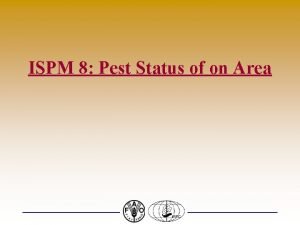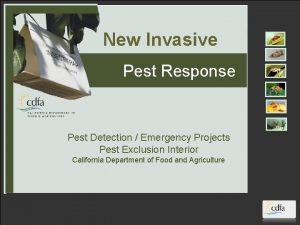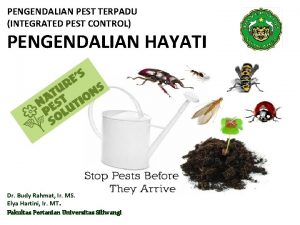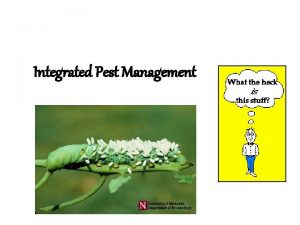PEST AND DISEASES OF GRAPES R R D


































- Slides: 34

PEST AND DISEASES OF GRAPES R. R. D. T. NIRANGA Department of Horticulture & Landscape Gardening Faculty of Agriculture & Plantation mgt Wayamba University of Sri Lanka

Diseases • • • Fungal Powdery mildew Downey mildew Rust Phomopsis cane and leaf spot disease Botrytis Bunch Rot Bacteria • Crown Gall of Grape Viruses • Grapevine fan leaf virus • Arabis mosaic virus • Rupestris stem pitting virus Pests • Grape Cane Borer • Mealy bug • Spider Mites • Berry eating creatures – Thief – Wasps – Ants – Birds – Squirrels • Vine girdler

Fungal Diseases

Powdery mildew (Uncinula necator) Powdery mildew affected bunch & leaves

Powdery Mildew on Fruits

Severe powdery mildew infection on grape leaf Spore (conidia) production of powdery mildew on a grape leaf Symptoms v. Powdery mildew produces white, powdery growth on grape leaves and shoots. v. Severely infected leaves may turn brown and fall off. Infected berries appear rusty or scaly. v. They may fail to mature properly or split open.

Ecology v The fungus survives the winter in infected grape tissue. v Wind carries spores long distances. v Unlike most other fungus diseases, powdery mildew tends to be most severe in dry growing seasons. Management Cultural Management § Less susceptible to powdery mildew. § Plant grapes in full sun with good air circulation Fungicides

Downy Mildew (Plasmopara viticola) Downy mildew on upper side of grape leaf. Downy mildew symptoms on a shoot Appearance of infection on underside of a leaf Downy mildew symptoms on fruits

Symptoms v Infected leaves develop yellowish-green, and translucent “oily” lesions on their upper surfaces. v On lower surfaces, the fungus produces a white to grayish cotton-like growth. v Affected leaves eventually turn brown, wither, curl, and drop early, exposing the immature berries to direct sun. v Berries that are infected when young turn light. Ecology v Spores are spread by splashing rain, wind, and through v The handling of plants.

Management Cultural Management v When planting grapevines, select sunny, open areas with good air movement. v Prune and train vines annually to maintain excellent air circulation v Control tall weeds and grasses in the planting area. Fungicides v If downy mildew is a problem, a program of fungicide sprays may be needed. v Captan, Copper compounds, (fixed coppers and Bordeaux mixture), Mancozeb, Ridomil/MZ, Ridomil /Copper, Sovran, and Ziram

Botrytis Bunch Rot of Grape (Botrytis cinerea) Discolored, shriveled berries caused by Botrytis Bunch Rot Botrytis cinerea sporulating on grape berries

Symptoms v Ripening grapes are affected by a rot v With sufficient rain and humidity, berries split open and develop a grayish mold on the surface. v Affected berries may shrivel in the dry climate. Ecology v Infection is optimal at 15 -20 o. C with free water or over 90% humidity. v Grape cultivars with dense canopies, thin skins, and/or tight clusters are more susceptible to botrytis bunch rot

Management Cultural Management v Prevent excessive vine growth by judicious use of water and fertilizer. v Prevent berry damage (powdery mildew birds and insects) v Canopy management Fungicides

Phomopsis cane and leaf spot disease (Phomopsis viticola) Infected leaves

Infected inflorescence

Lesions of Phomopsis cane and leaf spot on shoot and stem

SYMPTOMS v Phomopsis cane and leaf spot appears as tiny dark spots with yellowish margins on leaf blades and veins v Basal leaves with heavy infection become distorted and usually never develop to full size v On shoots, small spots with black centers similar to those found on leaves occur usually on a basal portion of the shoot v Heavy infection usually results in a scabby appearance of the basal portions of the shoot

Control Cultural practices v Increase air circulation in the vineyard v Removing diseased canes from the vine during normal pruning operations v This disease can be controlled by applying protectant fungicides before rainy weather begins Chemical control v Contact materials such as copper, sulfur, ziram, mancozeb, and maneb

Bacteria diseases

Crown Gall of Grape (Agrobacterium vitis)

Symptoms v Gall formation on the aerial part of the vines v Young galls are soft, creamy to greenish in color, with no bark or covering. v As they age, the tissue darkens to brown. v The surface becomes open and the texture becomes moderately hard and very rough Ecology v Spread through propagation of diseased wood.

Management Cultural Management v Select sites with good air and water drainage v Avoid vine stress due to poor nutrition or low p. H v pest control programs for nematodes v Do not propagate wood taken from galled vines v Hot water treatment of vines is effective in reducing crown gall infection levels in planting materials Fungicides

Pests of Grapes

Grape Cane Borer (Amphicerus bicaudatus) Adult Damage

Grape cane borer egg Grape cane borer larva Grape cane borer pupa

Damage v Small holes can be seen on the vine v Bore the vine and weaken the vascular functions v Vine become weak and dry Management cultural practices v such as removal and destruction of affected canes Chemical practices

Spider Mite (Tetranychus pacificus) Damage v Mites feeding on the undersides of the leaves may cause foliage to turn a bronze color. v Leaf bronzing early in the season causes stunting and reduces berry quality. Management Cultural Management v Good irrigation and fertilizer practices help offset damage to foliage.


Nutrient deficiencies

Boron deficiency

Potassium deficiency

Boron-deficiency


 Pest of grapes
Pest of grapes The fox and the grapes genre and subgenre
The fox and the grapes genre and subgenre On a hot summer day
On a hot summer day The developing person through the life span 9th edition
The developing person through the life span 9th edition Grapes and figs
Grapes and figs Modern lifestyle and hypokinetic diseases
Modern lifestyle and hypokinetic diseases Venn diagram communicable and noncommunicable diseases
Venn diagram communicable and noncommunicable diseases Section 19-3 diseases caused by bacteria and viruses
Section 19-3 diseases caused by bacteria and viruses Chapter 8 skin disorders and diseases review questions
Chapter 8 skin disorders and diseases review questions Chapter 6 musculoskeletal system
Chapter 6 musculoskeletal system Chapter 24 sexually transmitted diseases and hiv/aids
Chapter 24 sexually transmitted diseases and hiv/aids Chapter 22 genetics and genetically linked diseases
Chapter 22 genetics and genetically linked diseases Chapter 21 mental health diseases and disorders
Chapter 21 mental health diseases and disorders Chapter 17 reproductive system diseases and disorders
Chapter 17 reproductive system diseases and disorders Chapter 15 nervous system diseases and disorders
Chapter 15 nervous system diseases and disorders Plicatured nail
Plicatured nail Seborrheic keratoses
Seborrheic keratoses In what situation should a nail service not be performed
In what situation should a nail service not be performed Icd 10 morbus hansen
Icd 10 morbus hansen Cardiovascular system diseases and disorders chapter 8
Cardiovascular system diseases and disorders chapter 8 Pulp and periapical diseases
Pulp and periapical diseases Milady chapter 8 skin disorders and diseases
Milady chapter 8 skin disorders and diseases Venn diagram of communicable and non-communicable diseases
Venn diagram of communicable and non-communicable diseases Purulent diseases of lungs and pleura
Purulent diseases of lungs and pleura Tronsmo plant pathology and plant diseases download
Tronsmo plant pathology and plant diseases download Tronsmo plant pathology and plant diseases download
Tronsmo plant pathology and plant diseases download Albugo eye
Albugo eye Difference between communicable and noncommunicable
Difference between communicable and noncommunicable List of macronutrients and micronutrients
List of macronutrients and micronutrients Myths and fallacies about non communicable diseases
Myths and fallacies about non communicable diseases 10 diseases of lymphatic system
10 diseases of lymphatic system Conquer termites
Conquer termites Pest control in bath
Pest control in bath Swot and pest
Swot and pest Pest and disease control
Pest and disease control























